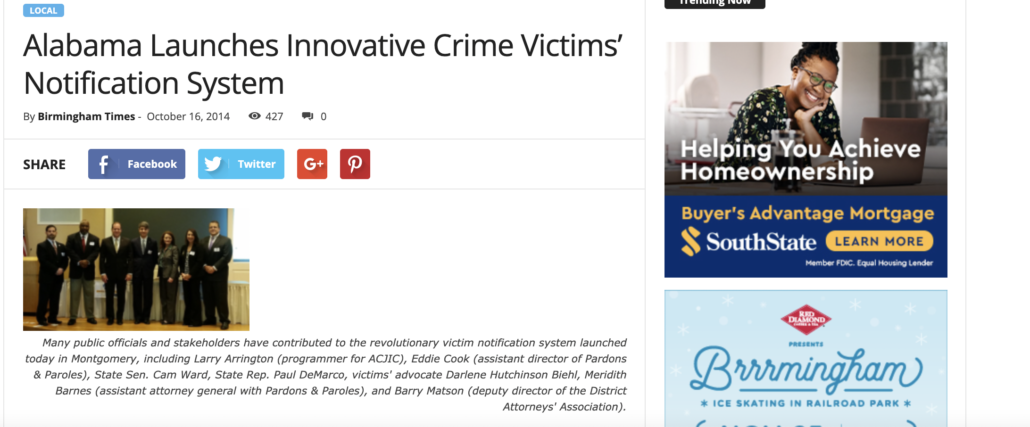By Eddie Burkhalter, Appleseed Researcher

Politicians across Alabama expressed concern and outrage when victims were not notified in advance of planned releases of several hundred people from Alabama Department of Corrections custody last week.
Those notifications didn’t happen because of underfunded, troubled victim notification systems and an unwillingness by an array of state leaders to fix these problems during more than a decade of dysfunction, Appleseed has learned.
These victim-notification shortcomings came to a head last week, upending what was supposed to be the orderly first phase of a supervised release program instituted in 2021 by bipartisan vote as part of a desperately needed effort to relieve crowding and ensure safe re-entry for incarcerated people nearing the end of their sentences.
As release day approached, court filings revealed that, contrary to the written letter of the law, the Alabama Department of Corrections (ADOC) had notified fewer than 20 victims affected by the pending release of approximately 400 incarcerated people, which began last week.
ADOC had more than 15 months since the law passed to notify these victims. What went wrong?
The problem dates back at least a decade and a half, and appears to be crime victim notification systems and departments that don’t share data between several systems and a failure of multiple state actors and agencies to address the problems, despite a law enforcement culture perpetually claiming to put victims first.
First, in 2008, the Alabama Criminal Justice Information Center was awarded a $465,000 grant from the U.S. Department of Justice’s Bureau of Justice Assistance to “enhance a statewide automated victim information and notification system in Alabama called AlaVINE.”
AlaVine is still active but appears only to be used by Sheriffs offices in Alabama.
ADOC uses its own stand-alone system that requires users to register online here. An ADOC spokesperson explained to Appleseed that ADOC’s system doesn’t automatically enroll victims. Because of this, many victims don’t receive notifications.
“If people don’t register, we don’t have their information,” the spokesperson said.
To complicate matters, the Alabama Attorney General’s office and the Alabama Bureau of Pardons and Parole use a separate notification system called the Alabama Victims Notification System, formerly called AlabamaCAN, but historically data from that system hasn’t been shared with ADOC.
Alabama Bureau of Pardons and Paroles Director Cam Ward told Alabama Political Reporter last week that the notification problem at ADOC may be because of ADOC’s notification system.
“The problem is that they don’t have access to the same database that we have,” Ward told APR, adding that this separation was enforced by law. “We need a new notification system.”
The ADOC spokesperson told Appleseed that the department started working with the AG’s office to gather victim information for the necessary notification of those being released under the 2021 law. Asked whether ADOC’s work with the AG’s office to obtain that victim information began last week, the spokesperson declined to directly answer, and wrote that “ADOC, ABPP, and the AG’s office are working together to ensure these notifications.”
Yet another attempt to solidify a uniform database came in 2011. That’s when Alabama lawmakers through the Alabama Act 2011-681 and Code 15-22-36.2 established the “Implementation Task Force” to support implementation of a statewide notification system that was later named the Alabama Crime Victims Automated Notification System, or AlabamaCAN, which is now called the Alabama Victim Notification System and is known as VNS.
The code also established the “Victim Notification System Fund in the State Treasury” to be paid out by the Alabama Law Enforcement Agency (ALEA) at the direction of the task force.
The task force was to meet first on March 1, 2012, and once members voted that a system complied with requirements in Alabama codes, the task force was to “automatically convert to the Victim Notification Oversight Council…”

Press coverage in October 2014 lauded an “innovative” crime victim notification system. Appleseed has learned of over a decade of underfunding and an unwillingness by an array of state leaders to fix the troubled victim notification systems.
AlabamaCAN launched in October 2014 and was supposed to allow victims to be notified of parole hearings “via email, text message or automated phone call.”
Press coverage lauded the “innovative” crime victim notification system and featured photos that included then-State Rep. Paul DeMarco and victims advocates as part of a task force implementing the new system. At the time, then-House Judiciary Committee Chair Paul DeMarco was quoted by WBRC as saying: “In the past not all of the victims were getting notified. I think that is the most important part of this legislation. We are going to be sure everyone gets notified.”
DeMarco recently weighed in on the early releases, but made no mention of this system.
From the very start AlabamaCAN was troubled, not in small part due to a lack of funding and coordination.
The Council of State Governments in a 2015 report noted that “Alabama’s automated victim notification system is not operational and not all victims are notified when people are released from prison to the community.”
“AlabamaCAN is not yet operational due to a lack of financial resources to complete the system, so victims are only able to receive notification by U.S. mail,” researchers wrote in the 2015 report. “Currently, not all victims are notified when an offender is released from prison. There are gaps in the DOC notification process, such as victims not always being notified if the offender is released from prison for medical treatment or is released to a CCP work release program.”
More attempts to fix the issues came along in 2016.
Then-Gov. Bentley announced a $1.2 million grant to ALEA to expand the Alabama Victim Notification program. It’s unclear how that money was spent: an ALEA spokeswoman received Appleseed’s questions regarding that grant, but did not provide responses as of the publishing of this piece.
Suddenly, a year later, after Gov. Kay Ivey was first sworn into office in 2017, the Alabama Legislature sent Ivey a General Fund budget that stripped all money for the victim notification system.
“This was something that was promised to victims two years ago when they were wanting to release more inmates from prison to help us take the notification system to a new level,” then-president of a chapter of a statewide crime victims advocacy group told WSFA 12. “And two years later, the funding is already being eliminated. That’s very unfortunate and we hope that they’ll restore it in future budgets.”
On Feb. 21, 2020, ALEA issued a request for proposal for a new statewide victim notification system that would allow the various state agencies to access the same data.
Proposals were to be submitted by April 6, 2020, and the system was to be designed to “integrate with the Alabama Board of Pardons and Paroles (“ABPP”), the Alabama Department of Corrections (“ADOC”), and other state agencies as may be needed” but this request for proposal is listed on ALEA”s website as having been closed with “no award” given to any applying company.
ALEA has not since issued a similar request for proposal for a new notification system, according to the agency’s website.
While crime victims were left wondering whether Alabama’s leaders are serious about following through on their promises to put victims first, people incarcerated in Alabama’s violent, deadly prisons were subject to yet another failure at the hands of the agency that incarcerates them.
The notification problems have left those expecting to be released under the 2021 law living in limbo, and even some those who have been released were given only a bus ticket and ankle monitor.
A source within an Alabama prison told Appleseed that violence and fights had increased in the wake of the botched release. And an incarcerated person at Easterling Correctional Facility told Alabama Political Reporter last week that “some of those eligible for the early release had begun giving away food and hygiene items, only to be told they would not be released on Tuesday.”






Leave a Reply
Want to join the discussion?Feel free to contribute!